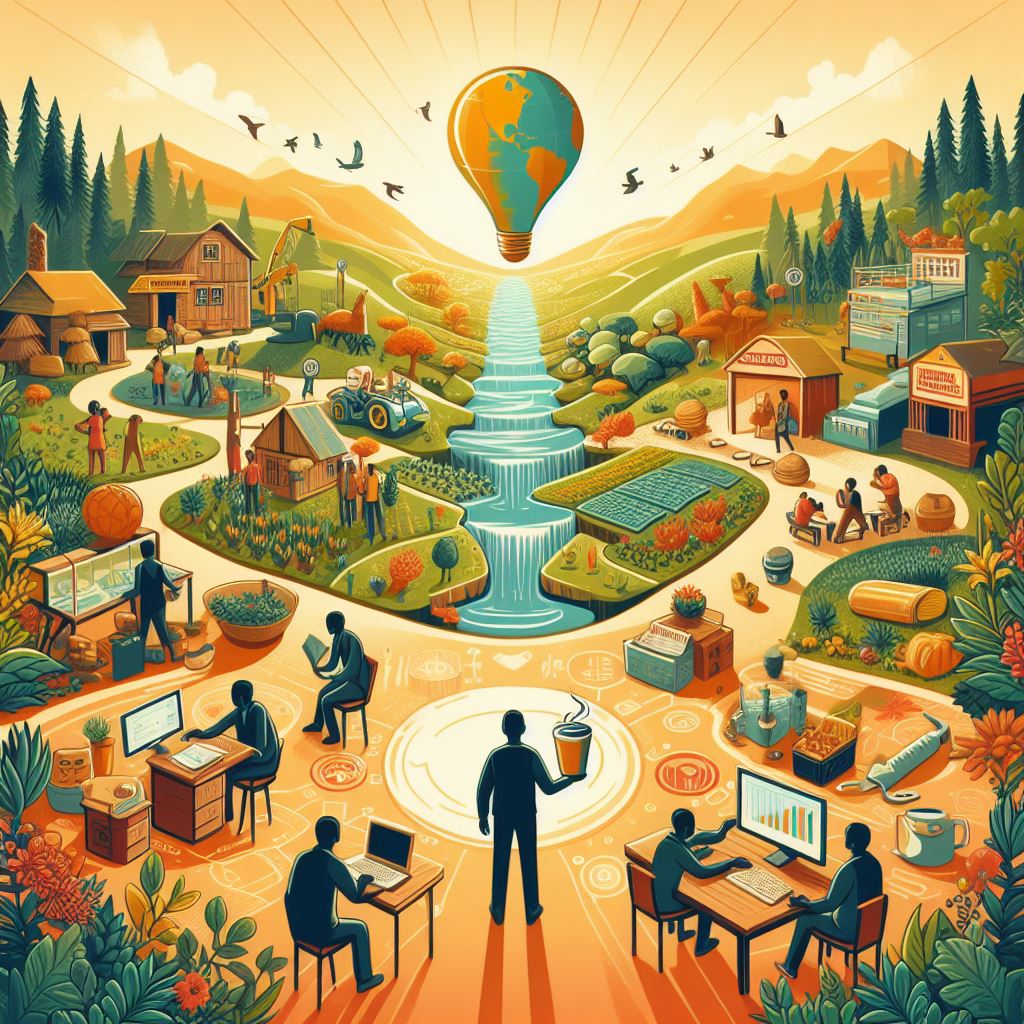Explore the transformative economic landscape of 2024 in this comprehensive article. Uncover key drivers of change, emerging challenges, and strategic opportunities for businesses. Learn how to navigate inflation, technological advancements, and geopolitical tensions while embracing sustainability for resilience and growth in a rapidly evolving global economy.
Introduction
Mapping the New Global Economy.
Staring at the year 2024, the world economy remains a system with dynamics shaped by the circumstances experienced over the last few years. It will be why COVID-19 has already driven changes towards digitalisation and how new emerging patterns of consumer behaviour can impact diverse sectors. Even the economies used to operate in the conventional patterns are suffering the symptoms of structural shift, triggered by the appearance of novelties in the form of new technologies and shifts in the consumer tastes. This article will identify the four critical shifts that are revolutionizing the economy and establish why the stakeholders need to be alert and active.
Purpose of the Article.
The goal of this article is to unpack the different economic features and potentials of the year 2024. This paper seeks to compile a comprehensive understanding of the current economic climate to assist policymakers, business people, and investors in operating in this new territory. This is why it is relevant to understand such factors – to develop strategies for resisting adversities, as well as to discern opportunities in the globally growing competition. In the further analysis of the main factors influencing change, we’ll define actions that can help stakeholders to benefit from new opportunities while minimising risks.
1.Growth Dynamics of the Economy in 2024.
Technology Developments.
The inherent drive of technology remains the single most driver of change to the ever-evolving economy in 2024. New technologies such as artificial intelligence, blockchain, and automation are emerging as industries promise never seen before transformation in the overall operation and service delivery systems. It means the companies using these technologies will secure better position on the market; they can update their work processes, improve customers’ satisfaction, and increase profitability levels. However, accompanying this process is fast advancement in technology, which brings along overwhelming challenges, especially in regards to the displacement of human capital, the skills gap, and attendant human capital requirements. The economic consequences are dramatic: power beautiful promises of vertical integration which operating departments obtain, while being burdened with preparedness for the fact that many employees may not be able to adapt to a world that is increasingly dominated by technology systems.
Geopolitical Tensions.
Political risk is another crucial influencing element in reshaping the economy while moving through the year 2024. Poly factorial involvement of international relations and trade policy alongside conflict within regions make the move difficult for the trade to happen. Handling such matters such as tariffs to territorial disagreements has broad consequences that transcend boundaries affecting supply chain and investment. Companies have to be sophisticated and accurate and come up with business models that will consider such unknowns. Besides, nationalism and protectionism will negatively affect the international integration process as a result of producing segmented markets and increased rivalry. In this volatile climate, geopolitical risk needs to be clearly defined in order to provide those companies attempting to compete in the global markets with a framework for success.
2. New Directions in International Business.
Inflation and Monetary Policy Adjustments.
Unemployment rate has considered inflationary inevitably after economic fluctuations have pushed economies globally to bring changes where central banks have revised their monetary policies in 2024. After many years of the 2008–2009 crisis, and despite excessive intervention by the world’s leading central banks, inflation risks have again emerged, and regulators must now find the right balance between economic growth and rising prices. These adjustments have far-reaching consequences for expenditure plans, be they individuals’ or firms’. An implication for these changes is that, to stay abreast and avert any loss, businesses have to look for new strategies concerning their pricing and costs that will help to cushion them against inflation and at the same time remain profitable.
Supply system interruption.
One of the challenges that have regrettably defined today’s global economy include uncertain supply chains, which are cut short by political strife, the impact of extreme weather conditions, and the postponation effects of the COVID-19 pandemic. The IT and business awareness of risks that are associated with global supply chains, therefore leading to the development of localized sourcing and diverse supply sources. Apart from delaying the delivery of products, disruptions disrupt efficiency and increase costs. It is imperative that in their quest for resiliency, companies make technological and efficient supply chain investments to counter these risks. Further, supply chain transparency and flexibility are going to be the key elements that will help to address the ongoing challenges resulting from an unstable environment on the global level.
3. Taking advantage of new opportunities.
Technological and Innovation Capital.
2024 is a sign of a new economy where people who invest in technology and innovation are sure to reap big. Some of the most promising areas for future development include fintech, artificial intelligence, and renewable energy, as more and more customers shift towards them, and as governments provide support. Those companies that will embrace these improvement can be in a position to not only increase productivity in their business but also to stand out from the competitors. In addition, there are gains in the areas of research and innovation to come up with solutions that will enable the world to solve some of the greatest problems facing the globe today like global warming, and lack of adequate health care facilities. Thus, by choosing innovation as the primary strategic direction, firms can create an image of being innovators and taking advantage of this economic dispensation.
Adopting sustainability as a strategic weapon.
Sustainability is no longer a fancy word on the lips of various businesses; it has become a key to business success by 2024. Since consumers are becoming aware of sustainable practices, the companies that adopt sustainable measures will have a competitive edge. This requires not only engaging in environmental management activities but also informing consumers and other stakeholders about them. When business goals are linked to sustainable development, customer loyalty and corporate image are improved in the marketplace. Also, governments and investors are shifting towards sustainable projects, which provide the right environment for companies to experiment and develop new solutions that will help to create a sustainable economy. Thus, sustainability is not just a moral imperative but also an economic essential; it is a matter of survival.
4. Strategic Framework for Businesses.
Risk Management Strategies.
In in an age of increased unpredictability, it is critical for organizations to build sound risk management frameworks if they are to survive and succeed in unfavourable economic conditions. First of all, an effective risk management framework should include the financial risks as well as operational, reputational, and geopolitical risks. Using such tools as the scenario analysis and stress testing, it is easier for organizations to identify and develop measures in case of risks posed by such threats. This kind of approach not only helps to protect from various unpredictable events but also prepares the companies for further successful development, taking into account the existing tendencies in the market. This paper concludes that businesses focusing on risk management in 2024 will be in a better position to manage the volatile global environment.
Building Resilience of Operations.
It is critical for companies intending to cope with economic difficulties to develop resilience within organizational operations. This requires the firm to adopt changeable business strategies that can easily be adjusted to accommodate new conditions in the supply chain or new consumer demands. This is why the use of technologies like the cloud and analytics must be leveraged to strengthen operational flexibility and allow organizations to act promptly and appropriately to new risks. Thirdly, a culture of innovation and improvement within the workforce plays an important role in supporting resilience. In the environment that is changing constantly, companies with a focus on operational resiliency will not only survive but will succeed in the environment that will be adverse to them.
5. Policy Implications and Recommendations.
Role of Governments in Economic Stabilization.
Thus, governments have a crucial function of managing economies in a time of changes in the global environment. Thus, the policies for 2024 will consider the problem of the further development of the state, given the presence of inflation and supply chain disruptions. Infrastructure, educational, and technological investments for the future can spur the economic regeneration process. However, there must be synergy between the governments and the private sector in order to develop a favourable climate for business development. Through protecting innovation and decreasing barriers to business, governments can ensure businesses learn and succeed in the constantly changing environment.
Encouraging Collaboration Between Public and Private Sectors.
Current realities present complicated problems for economies that require partnership between government and businesses. With this structure of stakeholders, it becomes easy for them to complement each other in order to address various challenges that face the world today, including poverty and global warming. PPPs can help partners pool resources, knowledge, and expertise in order to create value and foster growth of businesses and the economy. Furthermore, the integration of stakeholders of different backgrounds in the decision-making process might also improve the efficiency of the applied polices that are targeted at the promotion of resilience and sustainability. By 2024, it will have become necessary to work together in order to overcome the complex obstacles of the global economy as well as to achieve fair development for all.
Conclusion.
In conclusion, the global changes in the economy in 2024 can be characterized as great opportunities along with great risks for all the stakeholders. The threats include inflation and supply chain issues, technological advancement, and sustainability, among others. These make businesses continuously adapt to new changes. The lessons highlighted in this article prove the need for strategic planning, risk management, and innovation in the kind of uncertainty that characterizes the business world. When these drivers of change are identified, then opportunities for success can be availed by organizations in a competitive environment.
Looking to the future, the stakeholders need to be actively engaging in the management of the challenges of the global economy. Later on, whether through purchases of tangible assets or through partnerships with policy makers, the decisions made today determine the shape of tomorrow’s economy. In such a context, people who are ready to accept challenges, innovate, and cooperate will become leaders and take advantage of the opportunities that exist along with the risks.


























